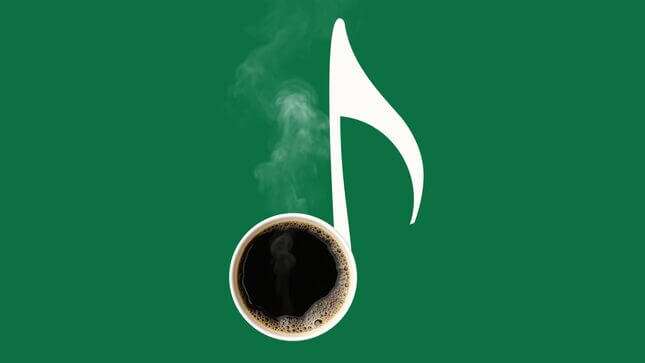How Starbucks Suburbanized Music and Almost Got Away With It
Entertainment
Illustration: Elena Scotti (Images: Getty, Shutterstock)
In the beginning, there was jazz.
In 1995, Starbucks seemed destined to expand infinitely, not unlike the universe. The brand had transformed from its humble early ’70s beginnings as a standalone coffee shop in Seattle into a national, publicly-traded chain. Smack dab in the middle of the ’90s, it launched the drink that would become its hallmark, the sugar-slush-caffeine concoction known as the Frappuccino. It also dipped its toe into the music business, a move that would ultimately yield Grammys, millions of dollars, and exclusive releases from beloved veteran acts like Ray Charles, Joni Mitchell, Carly Simon, and Paul McCartney.
But the beginnings of this arm of Starbucks’ business were practically unassuming. The brand’s foray into music arrived in the form of a 13-track compilation released via the legendary jazz label Blue Note that featured the likes of Billie Holiday, John Coltrane, Thelonious Monk, Louis Armstrong, and modern hip-hop/jazz fusers Us3, for good measure. The Blue Note Blend CD was sold alongside coffee of the same name (“a smooth, spirited complement to the improvisational quality of soulful jazz,” went the marketing copy). A Starbucks employee named Timothy Jones, whose professional designation was apparently “music specialist,” told AdWeek in 1998 that Blend ended up selling 75,000 copies. “That’s when we knew we were on the right track,” he added. He wasn’t wrong. At least, not yet.
While Starbucks was commodifying coffeehouse culture, it had similar designs for music. To give credit where it’s due: A jazz collection was hardly the most obvious route. Folk had been the form most commonly associated with java joints, a bean-and-note harmony that stretched back to the years after World War II. The intimacy of the coffeehouse—its very anti-bar nature—made it the perfect venue for someone singing quiet songs while accompanied by an acoustic guitar. New York’s Gaslight Cafe was perhaps the prototypical coffeehouse-as-folk venue. It opened in 1958 and after initially providing a stage for beat poets, the Gaslight started showcasing up-and-coming folk acts. Bob Dylan and Joni Mitchell were among those who played sets there, early in their careers. The Gaslight closed in 1971 but it left an indelible mark on culture.
Fast forward a few decades to when Starbucks was on its cultural ascent. Post lip-sync culture-pop in the early ’90s was consumed with expressions of “authenticity.” Unplugged was riveting MTV’s audience and singer-songwriters were plentiful, especially in the echelon of culture just below the mainstream. Folk and approximations of it were commercially viable again by the time Starbucks started dropping music.
Brands as varied as Pottery Barn, Lane Bryant, Rainforest Cafe, Au Bon Pain, Blockbuster Video, and Wonderbra were selling mixed CDs to their Clinton-era customers
Meanwhile, retail-specific music compilations were growing in popularity and ubiquity. These were not “cool” by any standard divested from mainstream norms—in the ’90s, hating corporations was practically an identity and by the early 2000s, Starbucks was practically synonymous with the very concept of corporate—but they were often successful. Victoria’s Secret’s mind-bogglingly popular line of classical discs launched in 1988 and by 1997, the retailer’s eight titles had reportedly moved more than 12 million copies in total. Brands as varied as Pottery Barn, Lane Bryant, Rainforest Cafe, Au Bon Pain, Blockbuster Video, and Wonderbra were selling mixed CDs to their Clinton-era customers. It was a tradition stretching back decades—tire companies Firestone and Goodyear had hawked vinyl Christmas compilations in the ’60s and ’70s.
But there was something about Starbucks in particular that made the whole endeavor sing. “If you’re standing in line, you have a good feeling and there’s a pleasant aroma. If you’re hearing music you like, you want to experience this feeling again, so you buy the CD,” a marketing expert (who didn’t work for Starbucks) told the Chicago Tribune in 2005.
The brand’s idea of selling music, according to a story in the August 1998 issue of Workforce, stemmed from one Starbucks manager’s dubbing of mixtapes that he’d play over his store’s system. David Brewster, from Starbucks product development, said in a 1998 issue of Nation’s Restaurant News that the marketing of CDs was a direct response to “our customers [wanting] to know where they could buy the music they heard in the stores.”
-

-

-

-

-

-

-

-

-

-

-

-

-

-

-

-

-

-

-

-

-

-

-

-

-

-

-

-

-

-

-

-

-

-

-

-

-

-

-

-








































